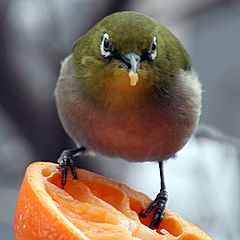Zosterops facts for kids
Quick facts for kids Zosterops |
|
|---|---|
 |
|
| Zosterops japonicus | |
| Scientific classification | |
| Kingdom: | |
| Phylum: | |
| Class: | |
| Order: | |
| Family: |
Zosteropidae
|
| Genus: |
Zosterops
Vigors & Horsfield, 1827
|
Zosterops is a large group of small birds, often called white-eyes. They get their name from the ring of tiny white feathers around their eyes, which looks like a pair of spectacles! These birds are found in many parts of the world, especially in warmer climates. There are many different species of Zosterops, each with its own unique features.
Contents
What Are White-Eyes?
White-eyes are small birds, usually measuring about 10 to 15 centimeters (4 to 6 inches) long. They have soft, fluffy feathers and a slender, pointed beak. Most white-eyes have green or yellow feathers on their backs and wings, with lighter colors on their bellies. Their most famous feature is the distinct white ring around their eyes. This ring helps them stand out and is why they are called "white-eyes."
Where Do White-Eyes Live?
White-eyes live in many different places around the world. You can find them in Africa, Asia, Australia, and many islands in the Pacific Ocean. They prefer warm areas and often live in forests, woodlands, gardens, and even city parks. They are very adaptable and can live in many types of habitats, from dense jungles to open grasslands.
What Do White-Eyes Eat?
White-eyes are mostly insect-eaters and nectar-eaters. They love to sip nectar from flowers using their brush-tipped tongues, which helps to pollinate plants. They also eat many small insects, like caterpillars and aphids, which they find on leaves and branches. Sometimes, they will also eat small fruits and berries. Their varied diet helps them survive in different environments.
How Do White-Eyes Behave?
White-eyes are very social birds. They often live in large flocks, especially outside of the breeding season. These flocks can have many birds, sometimes hundreds! They chatter and call to each other as they move through trees, looking for food. Their calls are often soft and musical. They are very active birds, constantly moving and searching for food.
Social Life of White-Eyes
Living in a flock helps white-eyes stay safe from predators. Many eyes can spot danger more easily. They also help each other find the best places to feed. When it's time to sleep, they often roost together in large groups in trees or bushes. This social behavior is a key part of their daily lives.
Reproduction and Life Cycle
White-eyes build small, cup-shaped nests in trees or bushes. Both the male and female birds help to build the nest and care for their young. The female usually lays 2 to 4 small, pale blue or white eggs. The eggs hatch after about 10 to 12 days. The baby birds, called chicks, are born without feathers and are completely dependent on their parents.
Raising the Young
The parents work hard to feed the chicks, bringing them insects and nectar. The chicks grow very quickly and are ready to leave the nest after about 10 to 14 days. Even after leaving the nest, the young birds often stay with their parents for a short time, learning how to find food and avoid dangers. White-eyes can live for several years in the wild.
Want to Learn More?
- In Spanish: Zosterops para niños

